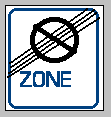Information Disclaimer: This is an unofficial collection
of European road sign conventions and rules.Whereas every effort has been
taken to ensure the accuracy of the information presented, there may be
errors and omissions.The entire risk as to results and performance of the
information rests with its user.
Prohibitory Signs - halting and parking,
also: Special Notes on City Parking
The distance over which a sign applies may be indicated
by Zusatzzeichen, a supplementary sign affixed below the traffic
sign where the condition begins, such as
 . Such a condition may be the prohibition of
. Such a condition may be the prohibition of
stopping
in the traffic lane, which is indicated by the sign
 .
.
Zusatzzeichen, a supplement to the sign below which it is affixed, are
used frequently. If only
a distance (x m) is shown, the parent's condition occurs
x m down the road. Also text pertinent to the
parent signal may be displayed on the Zusatzzeichen See our pertinent,vocabulary, Also, see the safety related examples.
-
Stopping for more than 3 min in the traffic lane (except
for loading or unloading goods or passengers) is considered parking, which
can be prohibited by the sign
 ,
either sign applying over the distance indicated, such as 200 m forward,
or alternatively, as marked by the pair of the
,
either sign applying over the distance indicated, such as 200 m forward,
or alternatively, as marked by the pair of the
sign
 and its cancellation-sign:
and its cancellation-sign:
 .
.
-
All of these signs apply not beyond the next street intersection
on the sign's side of the street. Note, the zone sign for prohibited parking
may indicate a length of time. This would be the maximum of permitted parking
and the display of a "Parkscheibe" is then automatically required, to be visible
through the windshield, and
the pointer set to within 1/2 h of arrival (Ankunftszeit, arrivée, llegado, arrivo):

-
When checking out your vehicle, make sure a Parkscheibe
is in the glove box.
Miscellaneous Notes:
- At least 3.0 m must be clear for the safe passage of vehicular traffic.
Because of this 3.0 m rule, vehicles are frequently parked with
right-side wheels on the pedestrian walk; be aware, however, this is tolerated
depending on locality. Also, sufficient clearance must be left for safe passage
of baby carriages and wheel chairs on the sidewalk.
-
No parking within 5.0 m of any pedestrian crossing or
driveway; likewise, not within 15 m from a public transport stop! That is at
eine Haltestelle, un arrêt, una parada:
 ,
and not within a taxi space:
,
and not within a taxi space:
 .
.
-
No parking near rails for street cars in service!
-
Parking only on the left side in streets with street-car
rails on the right side!
-
Parking in one-way streets on the side where other vehicles
are parked, on either side when there are none!
-
No parking after dark within town limits, except sufficiently
close to street lights in service, else with the parking lights switched
on. All street lights are supposed to be in service, except when the lamp post
is marked with a white-bordered red band!
-
No parking after dark outside town limits (see regulatory
signs), except with parking lights switched on!
-
States and communities follow various rules for towing
an illegally parked vehicle!
Special Notes on City Parking
-
Fines for illegal parking may be significant. There are cities that
authorize wheel clamps or towing. No reason to despair,
however - see below!
- The motorist is expected to look for a parking garage when entering unfamiliar
cities with an intention to park, particularly so in Germany, it being a
busy center of Europe's cross roads. Follow the rectangular
blue Parking signs with white lettering - see Parkplatz, below - pointing to
ein Parkhaus, eine Tiefgarage, un parcage, or un garaje-aparcamiento,
garaje subterráneo as the case may be (deutsch, français, español).
They point in the direction of a parking garage. Some communities do a better job
than others, placing enough of these signs.Motoring visitors in town are definitely
expected to hunt for such a sign. Many of these garages are large and below ground
Tiefgaragen, or maybe in a hill side.
Also look for the Information
sign! These places have maps showing the parking garages. Parking may be provided
for the information seekers, for a few minutes.
- Most of the parking garages in D, A, CH, and other countries are fully
automated, with no attentant personnel in evidence. Follow the
instructions on the machine, where knowledge of German or French might come in handy.
These automated systems function on a simple concept under which the parking
client proceeds in principle as follows.
- Drive in, stop at the ticket dispensing machine and get your entry time-stamped ticket
(quite like you would in a US parking garage), drive into an empty parking slot, and leave
your car there.
- When returning, find a cachier machine. Insert your parking ticket in the designated slot.
Insert at least the amount of cash the machine now displays. Receive any return cash and
the processed ticket. Find your car and drive to one of the garage exits. Stop at the
exit machine. Insert your processed ticket and wait for the beam to open. Voilà -
high-tech for minimized effort has just been demonstrated.
-
Because of the sheer number of vehicles, to find parking space may be
difficult. It depends on the day, time of day, country, and locality.
That most of the frustrations are avoidable through planning
ahead would seem to follow.
Indeed, city driving is frequently frustrated by lack of parking.
Even in the fortunate event when a parking space or one of
the parking garages is found at last, the distance
to destination may in the end be farther than from the original start.
Use of public transportation is often the best idea, particularly in many
cities. Ask your town folks! They know when and where
to take advantage of public transport. It is usually fast, efficient,
clean, and enjoyable. This means also punctual to the minute (A, CH, D),
so one can schedule ahead and catch one's connections.
Parkplatz (Parking)
The sign for parking allowed:  .
Look for additional signs that may be mounted on the post and may
be restrictive, allowing only residents to park with permit (Parkausweis,
permis de stationner, carnet de aparcar),
handicapped persons (Behinderte, handicapés, minusválidos),
or require a parking device (Parkscheinautomat, distributeur de
billets de stationnement) to be operated following the instructions
on the device.
.
Look for additional signs that may be mounted on the post and may
be restrictive, allowing only residents to park with permit (Parkausweis,
permis de stationner, carnet de aparcar),
handicapped persons (Behinderte, handicapés, minusválidos),
or require a parking device (Parkscheinautomat, distributeur de
billets de stationnement) to be operated following the instructions
on the device.
The additional sign "Nur mit Parkschein" is
reference to such a machine (Parkscheinautomat, distributeur de
billets de stationnement) for mandatory use. Go find and operate it!
When a car is shown with one wheel on the side walk,
below the P on the sign for permitted
parking, it permits side-walk parking of vehicles of no more than 2.8 t.


 . Such a condition may be the prohibition of
. Such a condition may be the prohibition of  .
. ,
either sign applying over the distance indicated, such as 200 m forward,
or alternatively, as marked by the pair of the
,
either sign applying over the distance indicated, such as 200 m forward,
or alternatively, as marked by the pair of the and its cancellation-sign:
and its cancellation-sign:
 .
.

 ,
and not within a taxi space:
,
and not within a taxi space:
 .
.
 .
Look for additional signs that may be mounted on the post and may
be restrictive, allowing only residents to park with permit (Parkausweis,
permis de stationner, carnet de aparcar),
handicapped persons (Behinderte, handicapés, minusválidos),
or require a parking device (Parkscheinautomat, distributeur de
billets de stationnement) to be operated following the instructions
on the device.
.
Look for additional signs that may be mounted on the post and may
be restrictive, allowing only residents to park with permit (Parkausweis,
permis de stationner, carnet de aparcar),
handicapped persons (Behinderte, handicapés, minusválidos),
or require a parking device (Parkscheinautomat, distributeur de
billets de stationnement) to be operated following the instructions
on the device.